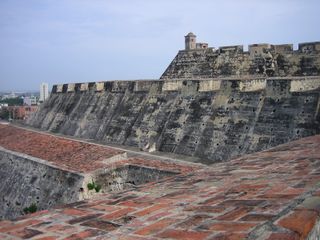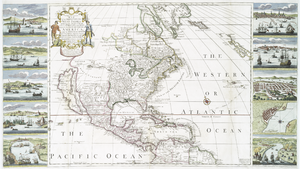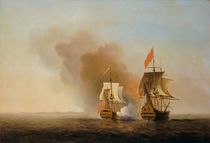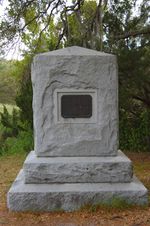حرب أذن جنكنز
| War of Jenkins' Ear | |||||||
|---|---|---|---|---|---|---|---|
| جزء من War of the Austrian Succession | |||||||
| |||||||
| المتحاربون | |||||||
|
|
| ||||||
| القادة والزعماء | |||||||
|
Edward Vernon Chaloner Ogle George Anson Charles Knowles Thomas Wentworth James Oglethorpe |
Sebastián de Eslava, Blas de Lezo Manuel de Montiano Andrés Reggio | ||||||
| الضحايا والخسائر | |||||||
|
20,000 dead, wounded, missing, or captured, 407 ships lost[4] |
4,500 dead, 5,000 wounded, 186 ships lost[بحاجة لمصدر] | ||||||
The War of Jenkins' Ear (Guerra del Asiento for the Spanish), was a conflict between Great Britain and Spain that lasted from 1739 to 1748, with major operations largely ended by 1742. Its unusual name, coined by Thomas Carlyle in 1858,[5] refers to an ear severed from Robert Jenkins, captain of a British merchant ship. The severed ear was subsequently exhibited before Parliament. The tale of the ear's separation from Jenkins, following the boarding of his vessel by Spanish coast guards in 1731, provided the impetus to war against the Spanish Empire, ostensibly to encourage the Spanish not to renege on the lucrative asiento contract (permission to sell slaves in Spanish America).[6]
After 1742 the war was subsumed by the wider War of the Austrian Succession involving most of the powers of Europe. Peace arrived with the Treaty of Aix-la-Chapelle in 1748.
. . . . . . . . . . . . . . . . . . . . . . . . . . . . . . . . . . . . . . . . . . . . . . . . . . . . . . . . . . . . . . . . . . . . . . . . . . . . . . . . . . . . . . . . . . . . . . . . . . . . . . . . . . . . . . . . . . . . . . . . . . . . . . . . . . . . . . . . . . . . . . . . . . . . . . . . . . . . . . . . . . . . . . . .
Background
At the conclusion of the War of the Spanish Succession, the Treaty of Utrecht in 1713 gave Britain a thirty-year asiento, or contract-right, to supply an unlimited number of slaves to the Spanish colonies, and 500 tons of goods per year. This provided British traders and smugglers potential inroads into the (traditionally) closed markets in Spanish America. However, Britain and Spain were often at war during this period, fighting one another in the War of the Quadruple Alliance (1718–20), the Blockade of Porto Bello (1726) and the Anglo-Spanish War (1727–1729).
In the Treaty of Seville (1729), following the Anglo-Spanish War, Britain had accorded Spanish warships the right to stop British traders and verify if the asiento right was respected. Over time the Spanish became suspicious that British traders were abusing the contract and began to board ships and confiscate their cargoes.[7] After very strained relations between 1727 and 1732, the situation improved between 1732 and 1737, when Sir Robert Walpole supported Spain during the War of Polish Succession. But the causes of the problems remained and when the opposition against Walpole grew, so did the anti-Spanish sentiment amongst the British public.[8]
وخلال ذلك تعاونت دعاية بولنبروك مع تلك الروح المقاتلة، التي اتسم بها برلمان تسلط المال على تفكيره، على إنهاء حكم ولبول الطويل وكان الوزير الحذر، الذي أقم سلطته على صون السلام، ينفر من التورط في خصومات مع الدول الأجنبية، فاتفق مع الكردينال فلوري-الذي كان يحكم فرنسا وفق مبادئ مماثلة-على الاحتفاظ أطول ما يستطاع بالسلام الذي أرسته معاهدة أوترخت، وترك فيما عدا ذلك إدارة العلاقات الخارجية لأخيه الكفء أوراتيو. ولكن احتفاظ إنجلترا بجبل طارق، وتنافس إنجلترا وأسبانيا على السيطرة على أمريكا والبحار، ولدا عنفاً أشد بمضي الزمن. وكان جورج الأول ووزيره ستانهوب قد أكدا لفليب الخامس ملك أسبانيا في يناير ويونيو 1721 أن إنجلترا ستتخلى عن جبل طارق حالما تسمح بذلك مالية بريطانيا ويرتضيه مزاج البرلمان. ولكن الشعب البريطاني أبى أن يرتضي هذا الاستسلام(45). فلنتابع الآن الرواية الإنجليزية في كيفية انزلاق إنجلترا إلى الحرب، فهي تبين غلو الجماهير في وطنيتهم ونزاهة المؤرخين البريطانيين(46).
تقول الرواية أن شركة بحر الجنوب "استغلت استغلالاً فاضحاً" ذلك الامتياز الذي منحته أسبانيا لإنجلترة، وهو السماح لها بإرسال سفينة تجارية واحدة في السنة إلى الممتلكات الأسبانية في الدنيا الجديدة، وأن "تجارة كبيرة غير مشروعة قامت"، تدير الشركة بعضها، وتغضي عن بعضها الآخر. وكان رد أسبانيا على هذا تفتيش السفن الإنجليزية المشتبه في قياها بالتهريب. وزعم روبرت جنكنز أنه في أحد هذه التفاتيش (731) فقد إحدى أذنيه، وقد احتفظ بها، وعرضها على الناس في بريطانيا، وطالب عالياً بالانتقام. وصادر الأسبان بعض السفن الإنجليزية المشتغلة بالتجارة المشروعة، وأبقوا الأسرى الإنجليز راسفين في الأغلال، وقبض القراصنة الإنجليز على بعض الأسبان وباعوهم رقيقاً في المستعمرات البريطانية. واستمر التهريب، واحتجت الحكومة الأسبانية، وتباطأ ولبول الذي كان يكره الانتقاص من دخل شركة بحر الجنوب المكافحة للبقاء، رغم أنه اشتد في عقاب التهريب على السواحل الإنجليزية. وحبذت طبقة التجار الإنجليز الحرب، واثقين من التفوق البحري، آمنين من الغزو، متطلعين إلى أسواق جديدة وتجارة متسعة. وأثارت ثائرة الشعب قصص الوحشية الأسبانية، الصحيح منها والباطل. وكان الإنجليز المطالبون باتخاذ إجراء في الأمر يشاد بهم وطنيين بواسل، أما الذين نصحوا بالاعتدال فرموا بالجبن والخور. وعرض جنكنز على البرلمان أذنه في زجاجة (مارس 1738)، فألقى بلتني، وبت، وغيرهما من المعارضين لولبول خطباً حماسية عن شرف إنجلترا . وفي لحن عسكري معارض نددت جماهير الشعب الأسباني بالإنجليز كلاباً مهرطقين، وانطلت عليها قصة زعمت أن ضابطاً إنجليزياً أكره أسبانيا نبيلاً على جدع أنفه وأكله.
The War
First attack on La Guaira (October 22, 1739)
أما الحكومتان فقد تصرفتا تصرفاً معقولاً. فنشر لاكوادرا، كبير الوزراء الأسبان، للاستهلاك الجماهيري خطاباً ساخناً وجهه إلى ولبول، ولكنه أخبره سراً بأن أسبانيا ترحب بتسوية النزاع بعد المفاوضة. ثم وقعت الحكومة البريطانية-في تحد لهذه الصورة الجماهيرية الصاخبة-اتفاقية ألباردو مع أسبانيا (14 يناير 1739) وفيها نزل كل من الجانبين عن أشياء، وشكلت لجنة لتسوية كل الشكاوي المعلقة. وقبل نصف الشعب الأسباني المعاهدة، ولكن إنجلترا بأكملها تقريباً أعلنت سخطها عليها. وشكت شركة بحر الجنوب من أن المعاهدة ستنتقص من دخلها وأرباحها انتقاصا شديداً، وكان السفير الإنجليزي بمدريد وكيلاً للشركة أيضاً. يضاف إلى هذا أن "الأزينتو" الذي سمحت أسبانيا بمقتضاه لإنجلترا بإمداد أمريكا الأسبانية بالعبيد الزنوج انتهى أجله في 6 مايو 1739، ورفض فليب الخامس تجديد العقد(45). ومع ذلك استدعى ولبول الأسطول الإنجليزي من البحر المتوسط مواصلاً سياسته السليمة، ثم ألغى الأمر بعد أن اشتبه خطأ في أن أسبانيا تبرم حلفاً سرياً مع فرنسا، وأمر الأسطول بحماية جبل طارق. واحتج لاكوادرا، وقطع ولبول المفاوضات مستسلماً لنوبة الحرب التي أصابت البرلمان والشعب، وفي 19 أكتوبر 1739 أعلنت إنجلترا الحرب على أسبانيا. واغتبط الشعب الذي كان لا يزال ينعت ولبول بالجبن، وراحت أجراس الكنائس تقرع في إنجلترا طولاً وعرضاً. وكتب الآن جيمس طومسن أغنيته الشعبية المثيرة "احكمي يا بريطانيا" التي أقسمت أن "البريطانيين لن يذلوا أبداً". وما من شيء يشد من أزر الحكومة عادة أكثر من إعلان الحرب، فعندها تكمم المعارضة المخلصة للوطن مدافعها.
Capture of Porto Bello (20–21 November 1739)
بيد أن وزارة ولبول كانت استثناء للقاعدة. فلقد أحس خصومه بحق أن وزارته غير متحمسة للجيوش الزاحفة أو للأساطيل التي تنفث النيران؛ وحملوا سوء إدارته تبعة الهزائم العسكرية كلها، وعزوا كل الفضل في انتصار بحري عند بورتو بيللو (على برزخ بنما) لعبقرية الأميرال فيرنون الذي كان أحد أعضاء المعارضة. وفي فبراير 1741 اقترح صموئيل سانديز على البرلمان أن ينصح الملك بإقالة رئيس وزرائه. وهزم الاقتراح، ولكنه لم يهزم إلا بفضل استجداء ولبول لأصوات الاستيوارتيين. وأفسح له في الوزارة عاماً آخر، غير أنه أدرك أنه قد حان حينه؛ وأن البلاد تريد تغييراً.
First attack on Cartagena de Indias (13–20 March 1740)

Destruction of the fortress of San Lorenzo el Real Chagres (22–24 March 1740)
Second attack on Cartagena de Indias (May 3, 1740)
Third attack on Cartagena de Indias (March 13-May 20, 1741)

Anson expedition
Florida
حياد فرنسا
Raids against Cuba and Venezuela
Invasion of Georgia
. . . . . . . . . . . . . . . . . . . . . . . . . . . . . . . . . . . . . . . . . . . . . . . . . . . . . . . . . . . . . . . . . . . . . . . . . . . . . . . . . . . . . . . . . . . . . . . . . . . . . . . . . . . . . . . . . . . . . . . . . . . . . . . . . . . . . . . . . . . . . . . . . . . . . . . . . . . . . . . . . . . . . . . .
Merger with wider war
By mid-1742 the War of the Austrian Succession had broken out in Europe. Principally fought by Prussia and Austria over possession of Silesia, the war soon engulfed most of the major powers of Europe, who joined two competing alliances. The scale of this new war dwarfed any of the fighting in the Americas, and had drawn the main attention of Britain and Spain to operations on the European continent. The return of Vernon's fleet in 1742 marked the end of major offensive operations in the War of Jenkins' Ear. This was confirmed by the entry of France into the war in 1744. France placed their emphasis on the war in Europe, and planned an ambitious invasion of Britain. While it ultimately failed, it further persuaded the British policy makers of the dangers of sending significant forces to the Americas which might be needed at home.
Although an expedition to seize the strategic French settlement of Louisbourg was launched by New Englanders in 1745, no further attacks were attempted on Spanish possessions.
Privateering
ثم أنه أرهق. كتب ابنه يقول "هذا الذي كان في السنين الماضية يستغرق في النوم حالماً يمس رأسه الوسادة.. لا ينام الآن أبداً أكثر من ساعة دون أن يصحو؛ والذي كان على المائدة ينسى دائماً أنه وزير، وكان أكثر مرحاً وخلواً من الهموم من جميع رفاقه، يجلس الآن دون كلام، وعيناه جامدتان، ساعة بطولها(50)". وجاءت الانتخابات الجديدة ببرلمان معاد له عداء ساحقاً، فهزمه في أمر قليل الشأن، وفي 13 فبراير 1742 استقال. وإذ كان أعجز من أن يواجه صخب مجلس العموم، فإنه لم يجد مشقة في إقناع جورج الثاني بأن يمنحه لقب ايرل أكسفورد، ويوصفه هذا هبط صعداً إلى مجلس اللوردات. وكان قد جمع ثروة طائلة تحسباً ليوم سقوطه.
Lisbon Negotiations
Aftermath
انظر أيضاً
Notes
- ^ Dewald, pp. ?-?
- ^ Woodfine,pp. ?-?
- ^ Hakim,p. 19
- ^ Newman and Brown, p. 744
- ^ Carlyle discusses Jenkins' Ear in several passages of his History of Friedrich II(1858), most notably in Book XI, chap VI, where he refers specifically to "the War of Jenkins's Ear"
- ^ Olson, pp. 1121-22
- ^ James, p. 59
- ^ James, p. 61
الهامش
- Dewald (ed.), Jonathan (2003). History 1450-1789. Charles Scribner's Sons. ISBN 0-684-31200-X.
{{cite book}}:|last=has generic name (help);|work=ignored (help) - Hakim, Joy (2002). A History of the US:. Vol. Book 3: From Colonies to Country 1735-1791. Oxford University Press. ISBN 0-19-515323-5.
- James, Lawrence (2001). The Rise and Fall of the British Empire. Abacus. ISBN 0-312-16985-X.
- Olson, James (1996). Historical Dictionary of the British Empire. Greenwood Publishing Group. ISBN 0-313-29366-X.
- Newman, Gerald (1997). Britain in the Hanoverian Age, 1714-1837. Taylor & Francis. ISBN 0-8153-0396-3.
- Woodfine, Philip (1998). Britannia's Glories. The Walpole ministry and the 1739 War with Spain. Suffolk: Boydell and Brewer. ISBN 0-86193-230-7.
- Gott, Richard. Cuba: A new history. Yale University Press, 2005.
- Lodge, Sir Richard. Studies in Eighteenth Century Diplomacy 1740-1748. John Murray, 1930.
- Pearce, Edward. The Great Man: Sir Robert Walpole Pimlico, 2008.
- Rodger, N. A. M. The Command of the Ocean: A Naval History of Britain, 1649-1815. Penguin Books, 2006.
- Simms, Brendan. Three Victories and a Defeat: The Rise and Fall of the First British Empire. Penguin Books, 2008.
- Browning, Reed. The Duke of Newcastle. Yale University Press, 1975.
Further reading
- Tobías Smollet (Tobias Smollett), Authentic papers related to the expedition against Carthagena, by Jorge Orlando Melo in Reportaje de la historia de Colombia, Bogotá: Planeta, 1989.
- The American People (sixth edition) by Gary B. Nash and Julie Roy Jeffrey.
- Victoria, Pablo (2005). El día que España derrotó a Inglaterra: de cómo Blas de Lezo, tuerto, manco y cojo, venció en Cartagena de Indias a la otra "Armada Invencible". Áltera, Barcelona, Spain. ISBN 84-89779-68-6.
- Quintero Saravia, Gonzalo M. (2002). Don Blas de Lezo: defensor de Cartagena de Indias. Editorial Planeta Colombiana, Bogotá, Colombia. ISBN 958-42-0326-6. In Spanish.
وصلات خارجية
- Proposals relating to the war in Georgia and Florida, 1740—a document suggesting strategies by which General James Oglethorpe might defeat the Spanish during the War of Jenkins' Ear, from the collection of the Georgia Archives.





